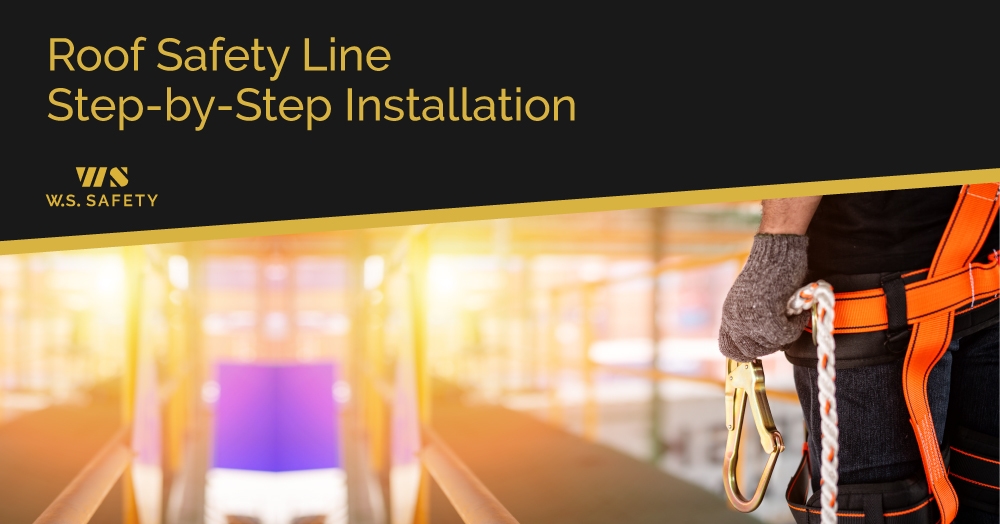A roof safety line, also known as a lifeline, is typically a horizontal line connected between two points.
The line is connected to a lanyard, which is then connected to the harness of a worker.
Because it is installed parallel to the surface of the roof, the worker is able to walk back and forth over the span of the roof unhindered while having the proper fall restraint and fall arrest safety measures in place.
Whether your occupation regularly takes you on rooftops, or whether you’re the practical, hands-on type who occasionally needs to get up on your roof at home, learning how to properly use roof lifeline systems is an important safety measure.
Government regulation states that anyone working at heights of greater than 10 feet – including roofers, painters, and workers installing solar panels or wind turbines – must wear appropriate fall protection equipment and take all relevant precautions.
Let’s take a look at how to secure yourself on a roof and avoid the risk of falls and injury.
USE A ROOF SAFETY LINE TO GET UP SAFELY
While it might go without saying, getting up on the roof safely is the first important point.
A roof extension ladder should extend at least three feet from the roof edge. Ensuring that the ladder is level and secure might require placing some boards under the legs if terrain is uneven.
The bottom of the ladder should be secured to stakes using rope or wire, and the top secured to anchor points like a rafter on the building.
It’s also worth keeping in mind that weather conditions can greatly heighten the risk of traveling to a high surface such as a roof. It’s best to work on a clear day without excessive wind or moisture as this can make the ladder slippery.
Vertical safety lines can be used with a rope grabber system to enhance height safety for workers going up and down a ladder with equipment.
SAFETY HARNESS ANCHOR POINTS
Appropriate roof safety line systems will consist of a simple ABC – that is, an anchor, a body support device, and a connecting device.
The recognized standard for safety lifelines involves wearing a harness that is attached to an anchor point by way of a lanyard.
How you decide to secure yourself on a roof will depend on the type of surface and the nature of the work. The most important factor while using a harness is to ensure a secure anchor point. There are several ways to do this.
Let’s take a look at the most commonly used options.
TEMPORARY ROOF ANCHOR
In many situations, utilizing a temporary anchor point is the ideal solution.
Jamb anchors are one kind of temporary roof anchor that mount in a door or window frame, consisting of clamps that attach by rope and hook to a safety eye. It’s worth noting that if a suitable outdoor window frame is not available, a jamb anchor can be mounted on a doorway inside a building providing it is on a supporting wall.
Another kind of temporary roof anchor is a sling, a strap connected by safety hook to a rope that runs over the roof to the opposite end of the work location.
The sling must be connected to a strong, heavy object like a large tree or even the towing eye of a van or large truck.
Because the use of a sling does not require drilling into any surfaces, it is the least invasive and most simple anchoring method for a roof safety line.
PERMANENT ROOF ANCHOR POINTS
A fixed anchor point is created by drilling into a usable surface like a supporting wall or a roof support beam. If you are part of a work team doing a job for a client, bear in mind that the client will need to approve the drilling before it can take place. The cable is attached by hook to the safety eye, and then attaches to the user’s harness on the other end.
There are different types of lifeline anchors that will be suitable for different roof surfaces. If you’re unsure, always get an experienced opinion before trying it yourself.
STEP-BY-STEP
Now that we’ve covered the basics of roof safety solutions, here’s a simple step-by-step breakdown of how to install and use roof lifeline systems properly.
- Secure an anchor point. Depending on the work surface, this may be done several different ways, either using a temporary anchor point like a tree, or by drilling a hole in a supporting beam or wall and using an eye bolt and hook to connect to the user’s cable line.
- Secure the other end of the cable.
- Fasten safety harness properly to the line. Make sure you are following the manufacturer’s instructions carefully, and always remember to inspect your equipment for any signs of rust, corrosion or fraying before use. Even when employed and installed correctly, roof safety line systems should be considered useless if they are damaged.
When working on roofs, safety should always be your first concern.
A vertical lifeline can enhance height safety for workers climbing up a ladder, especially if they are transporting equipment.
A horizontal roof safety line allows workers to move efficiently on a roof or other high surface while having the necessary fall protections in place.


